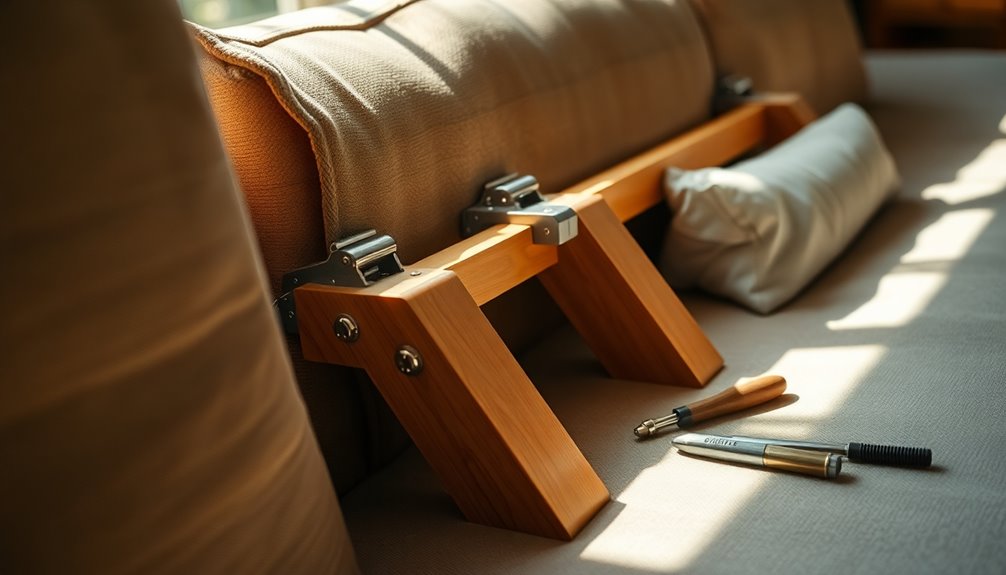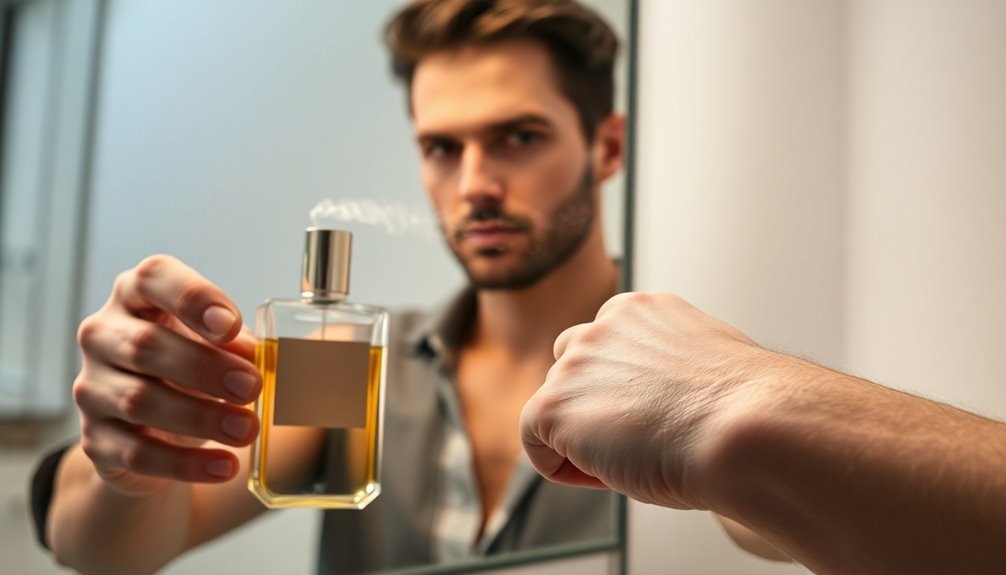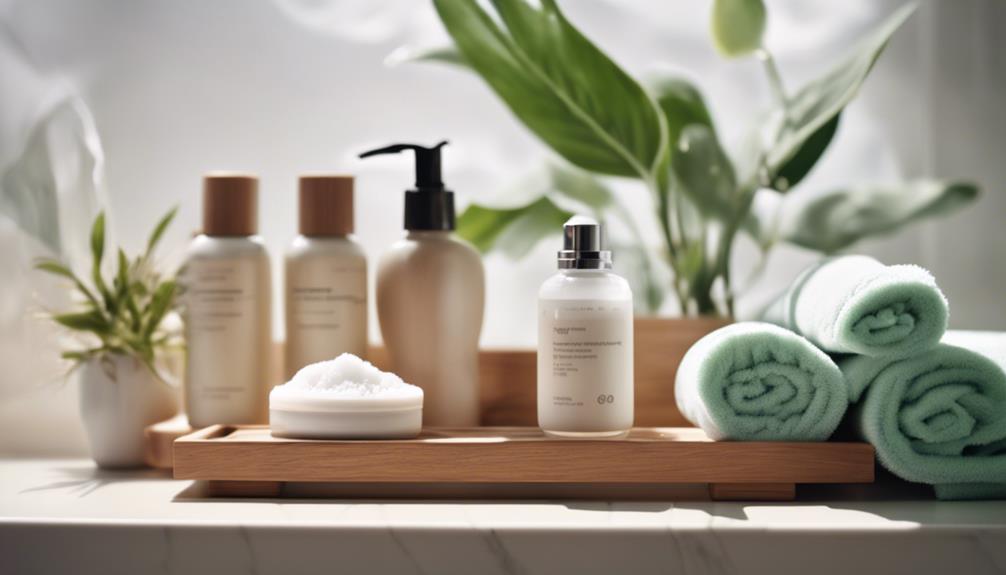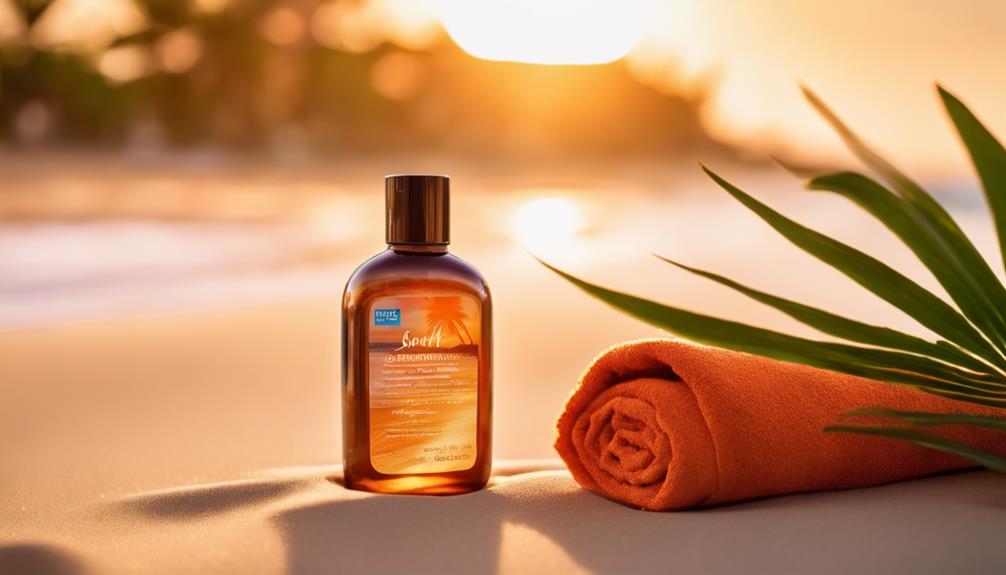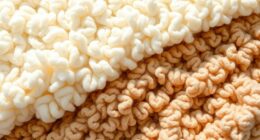Sustainable hair texturizing uses eco-friendly products and methods that nurture your hair and the environment. Focus on natural ingredients like coconut oil, sea salt, and aloe vera for nourishment and hydration. Brands like Oway and The Green Kiss offer cruelty-free options without harmful chemicals. You can also explore heat-free styling techniques, such as braiding or air drying, to create texture without damage. For a DIY approach, mix ingredients like Epsom salt and distilled water for a natural texturizing spray. Want to fine-tune your techniques and explore more sustainable options? The insights wait for you ahead.
Key Takeaways
- Utilize eco-friendly ingredients like sea salt and coconut oil in DIY texturizing techniques for natural texture and nourishment.
- Opt for sustainable brands like Oway and All Natural Collection that use plant-derived ingredients to enhance volume and health.
- Explore heat-free styling methods such as air drying and braiding to maintain hair health while achieving desired texture.
- Invest in eco-friendly tools, like bamboo brushes and refillable bottles, to reduce plastic waste in your hair care routine.
- Consider visiting sustainable salons that use eco-friendly practices and provide professional texturizing services for optimal results.
Benefits of Sustainable Hair Care

Embracing sustainable hair care not only enhances your personal well-being but also supports the planet. By choosing organic and natural products, you're avoiding harsh chemicals like sulfates and parabens that can irritate your scalp and strip your hair of its natural oils. This means less sensitivity and fewer allergies, making these products ideal for those with delicate skin. You'll also find that ingredients such as tea tree oil and aloe vera help soothe your scalp and alleviate dryness, promoting overall scalp health.
Sustainable options focus on nourishing your hair from the inside out, leading to stronger, more resilient locks. Reducing exposure to harmful substances is crucial, as it promotes overall health and well-being. While you're investing in your hair's long-term health, you're also making a positive impact on the environment.
Organic products often come with minimal or biodegradable packaging, reducing plastic waste. Plus, supporting sustainable brands often means backing fair trade practices and ethical sourcing, which benefits communities and upholds industry standards.
Eco-Friendly Ingredients to Look For
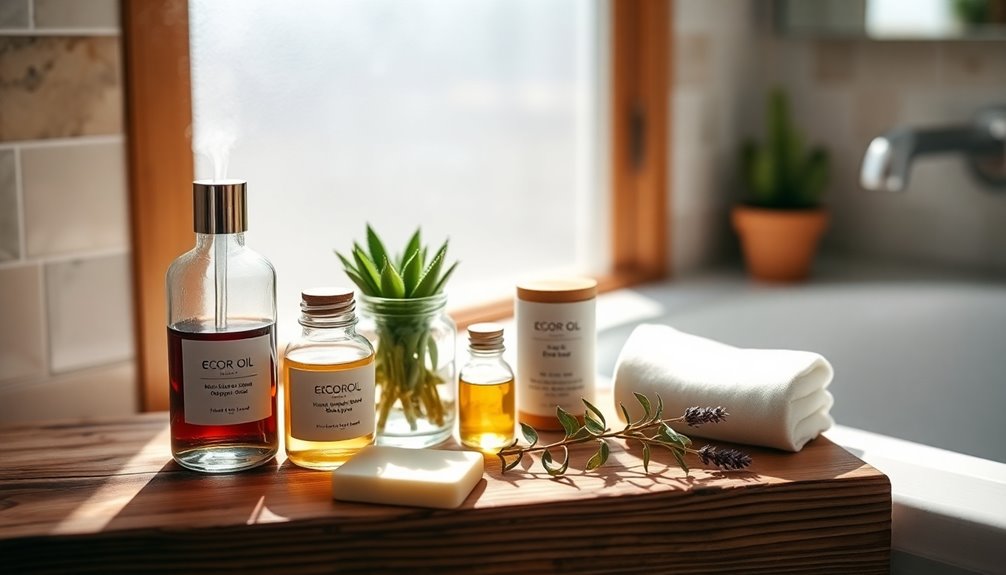
When shopping for sustainable hair care products, keep an eye out for eco-friendly ingredients that can truly benefit your hair and the environment.
Look for natural oils like coconut oil, which nourishes and adds moisture, or shea butter that softens and smooths your locks. Argan oil is another excellent choice, known for its protective properties. Additionally, many brands are committed to sustainability, as seen in their commitment to sourcing practices, ensuring that the ingredients are ethically produced. The incorporation of nutrient-dense ingredients like chia seeds in hair products can also provide added benefits for overall hair health.
Plant-derived extracts are also worth considering. Aloe vera hydrates and soothes both hair and scalp, while guar seed extract eases combing and prevents static.
Don't forget about sea kelp extract, which adds texture and aids in styling.
Natural salts and minerals can enhance your hair's look too. Sea salt adds texture and purifies the scalp, while Epsom salt helps you achieve those coveted beachy waves.
Choosing Texturizing Products Wisely
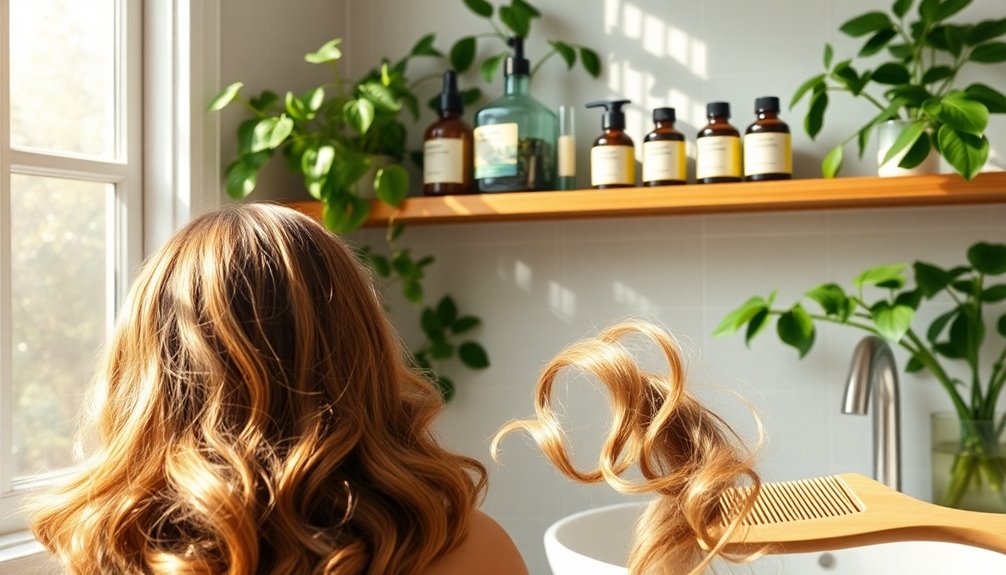
Finding the right texturizing products can significantly enhance your sustainable hair care routine. To start, avoid synthetic chemicals like PVP and acrylate copolymers. These petrochemical-derived ingredients can harm your scalp and lead to allergic reactions, ultimately damaging your hair over time. Instead, seek out eco-friendly alternatives that use plant-based bio-polymers, which nurture rather than hinder your hair's health.
Next, prioritize cruelty-free and vegan options. Look for certified vegan products, ensuring they contain no animal-derived ingredients and are produced without harming animals. These products often align with sustainable practices, making them a smart choice for eco-conscious consumers. Additionally, many of these vegan formulations ensure no animal-derived ingredients are used, further supporting ethical practices.
Packaging also matters. Opt for biodegradable products that break down naturally and reduce environmental pollution. Refillable containers are an excellent way to minimize plastic waste while supporting brands committed to sustainability.
Lastly, focus on natural and organic ingredients. Products rich in plant extracts and oils, free from harsh chemicals like sulfates and parabens, provide nourishment and enhance your hair's natural texture. Trusted brands that emphasize sustainability are your go-to sources for these beneficial ingredients. By making informed choices, you can truly transform your hair care routine.
Heat-Free Styling Techniques
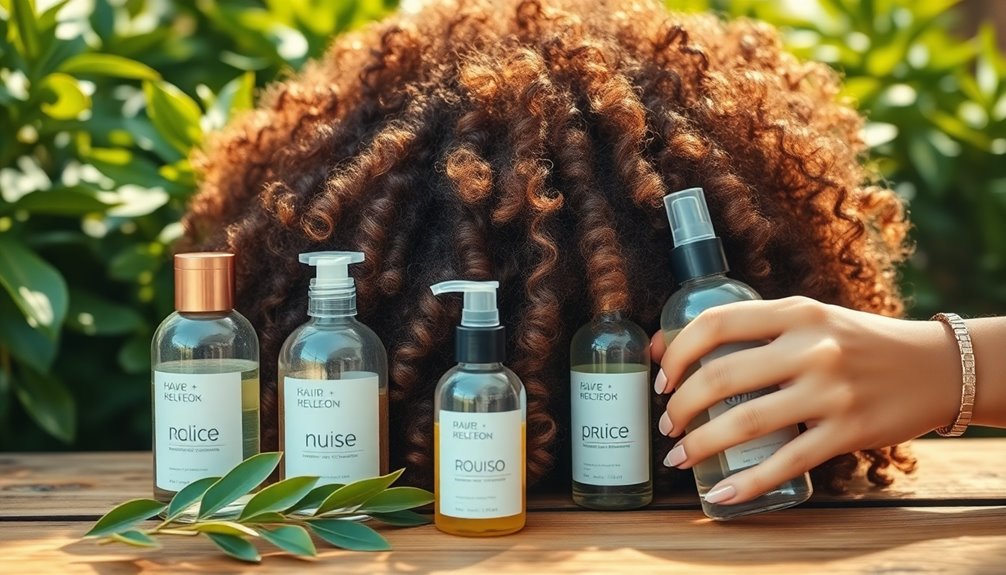
Heat-free styling techniques offer a simple way to achieve beautiful hair without the damage caused by hot tools. One effective method is air drying, which helps preserve your natural texture. Start by using a moisturizing shampoo and conditioner, especially if your hair tends to be dry. After washing, gently blot excess moisture with a towel—not rubbing—to prevent frizz. To enhance volume, apply a volumizing product like Moroccanoil's Root Boost, and don't forget a leave-in conditioner to keep static at bay. Incorporating products with glycolic acid can also improve scalp health, contributing to overall hair vitality.
Another fun technique is braiding or twisting damp hair before bed. Divide your hair into sections, braid each one, and let it dry overnight for defined waves. For a tousled look, twist your hair and secure it, using a curl-enhancing cream for extra definition. Avoiding heat tools not only protects your hair but also promotes healthier hair that is bouncy and easy to style.
You can also use accessories creatively. Scarves can transform into chic headbands or wrap around ponytails for added texture. Flexi rods are great for creating curls—just roll your hair around them and secure.
With these heat-free methods, you'll not only protect your hair but also embrace its natural beauty!
Natural Methods for Texturizing
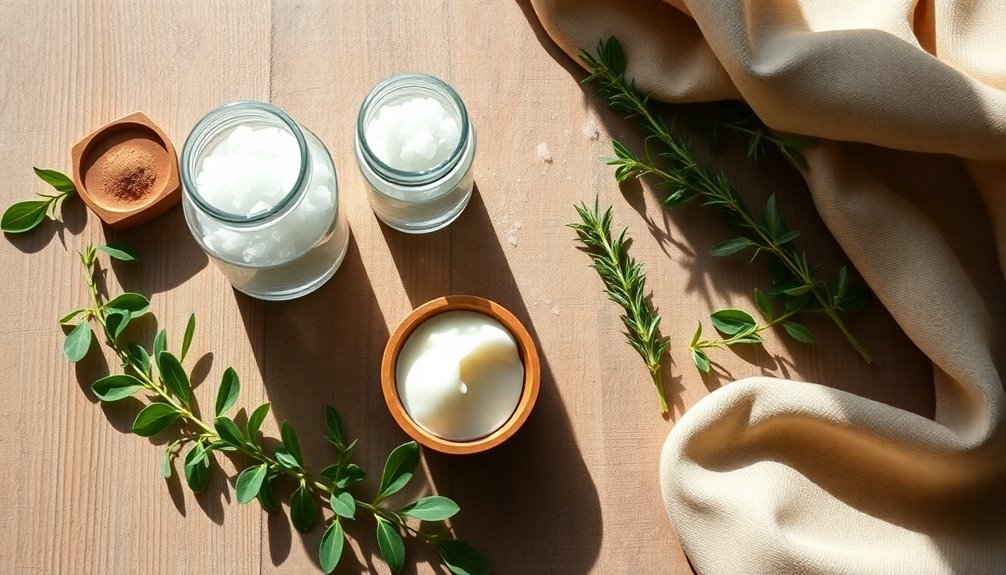
Embracing natural methods for texturizing allows you to enhance your hair's beauty without the risk of damage from chemicals or heat. Techniques like twist outs and braid outs define curls and waves beautifully, and using curl-defining creams or gels makes all the difference. If you want bouncy, voluminous curls, consider flexi rods or perm rods—they're great for achieving various curl patterns without harsh treatments.
For heatless stretching, banding and African threading are excellent options that elongate your hair while keeping its natural texture intact. Protective styles such as braids, twists, and locs shield your hair from environmental stressors, while natural updos like sleek high buns or intricate flat twists showcase your hair's beauty without altering its texture. Additionally, incorporating structured moisture routines into your hair care regimen can significantly enhance hydration and overall health.
Maintaining your hair's health is equally important. Establish a solid moisture routine with deep conditioning treatments and sulfate-free products tailored for your hair type. Remember to assess your hair's texture to choose the best styling approach. By prioritizing gentle styling techniques and regular trims, you can preserve your hair's natural texture while enjoying stunning styles.
Popular Eco-Friendly Brands
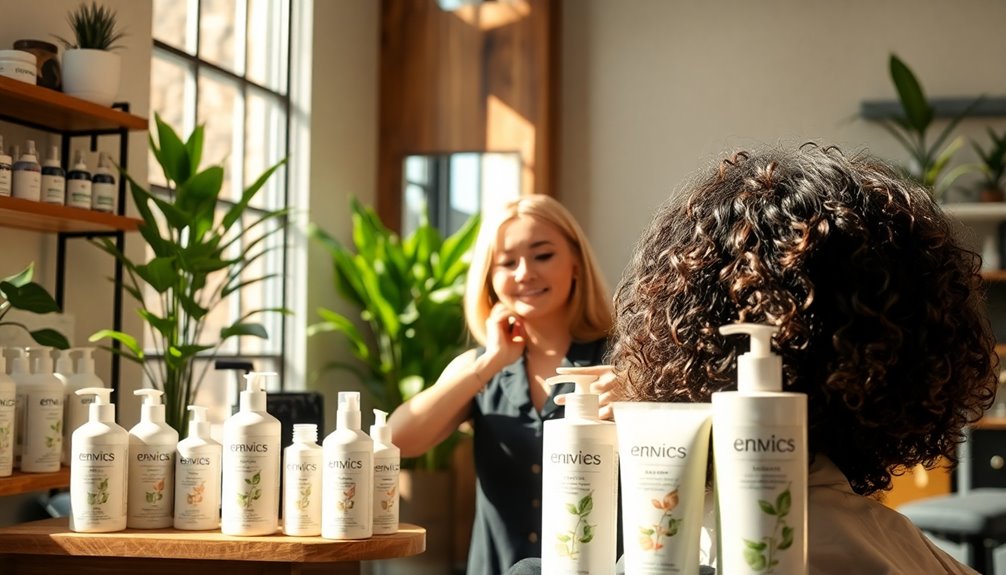
For those who prioritize natural methods of texturizing, choosing eco-friendly brands can further enhance your hair care routine while supporting sustainability.
One standout is Innersense Organic Beauty, offering a range of natural styling products like Hair Love Prep Spray and Quiet Calm Curl Control. Their formulations are free from silicones, sulfates, and parabens, ensuring a clean experience. Lightweight formulations are essential for preventing heaviness, making these products an excellent choice for fine hair.
Another excellent choice is Oway, which utilizes plant and mineral ingredients in products such as Sea Salt Spray and Bodifying Hair Renewer. Their focus on natural formulations means you can achieve volume and texture without harsh chemicals.
If you're looking for variety, check out All Natural Collection, featuring brands like Evolvh and Carina Organics. They emphasize high-quality, non-toxic ingredients while providing silicone-free and paraben-free options.
Lastly, The Green Kiss offers non-toxic, cruelty-free products, including brands like 100 Percent Pure, designed to nourish and protect your hair. Their commitment to avoiding synthetic fragrances and harsh aerosols makes them a smart choice for eco-conscious consumers.
Embracing these brands not only elevates your hair game but also aligns with your values of sustainability.
Sustainable Packaging Solutions
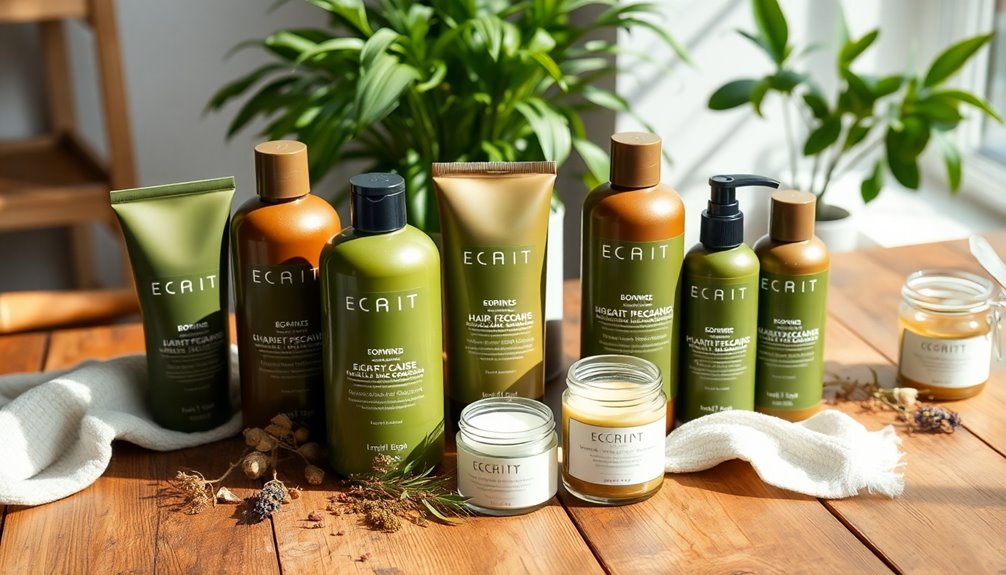
When it comes to sustainable hair texturizing, packaging plays a crucial role in reducing environmental impact. Brands like Zotos and Wella are leading the way with innovative materials.
Zotos uses 100% recycled paperboard for its product cartons, saving 2725 pulp trees and significantly cutting down landfill waste. This packaging initiative reflects Zotos' commitment to environmental solutions in the hair care industry. Wella's hair color tubes are made from 100% recycled aluminum, which cuts energy consumption by 66% compared to new materials. Understanding sustainable practices can help consumers make informed choices about their hair care products.
You'll also find AG CARE focusing on sustainability with bottles made from at least 30% post-consumer regrind, aiming for 100% in the future. Their refill pouches use 73% less plastic, diverting more waste from landfills.
Cult and King takes it a step further with refillable bottles that use 75% less plastic and are 100% recyclable, reducing solid waste by up to 86%.
Moreover, many brands are committed to renewable energy. Zotos' cartons are created using 100% wind energy, offsetting significant carbon emissions.
Essential Texturizing Techniques
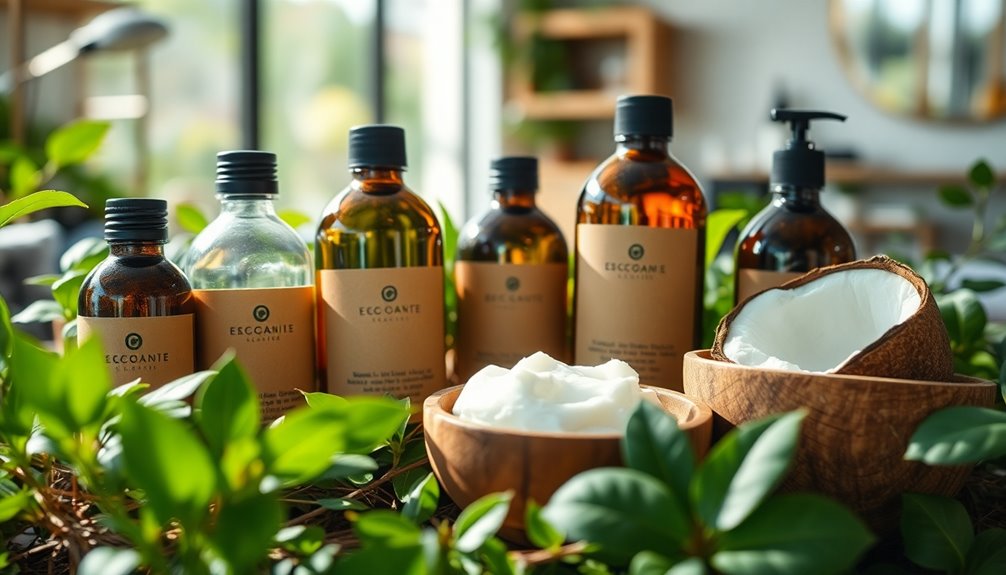
In the world of hair styling, mastering essential texturizing techniques can transform your look and enhance your hair's natural beauty. Layering is a fundamental technique that creates movement and removes excess weight, making it suitable for all hair types. Layering techniques can be tailored to complement your face shape and hair density for optimal results.
You can also try point cutting, which softens edges by cutting hair vertically. For a modern finish, internal cutting removes segments lengthwise along the hair shaft.
Twist cutting and slide cutting further enhance texture; twist cutting involves twisting your hair and cutting it for a thinned-out look, while slide cutting thins hair by slithering the scissors from mid-lengths to ends.
If you're working with thicker hair, consider using thinning shears, which have a guard on one blade to remove some hair with each cut. For curlier types, chunking shears are ideal, while texturizing shears create a natural look.
Blending shears seamlessly integrate layers, and finishing shears even out the texture after texturizing.
Incorporating backcombing or teasing can add volume, while curling techniques and braids infuse more texture.
Embrace these techniques to elevate your styling game and showcase your hair's beauty sustainably.
Tools for Effective Texturizing
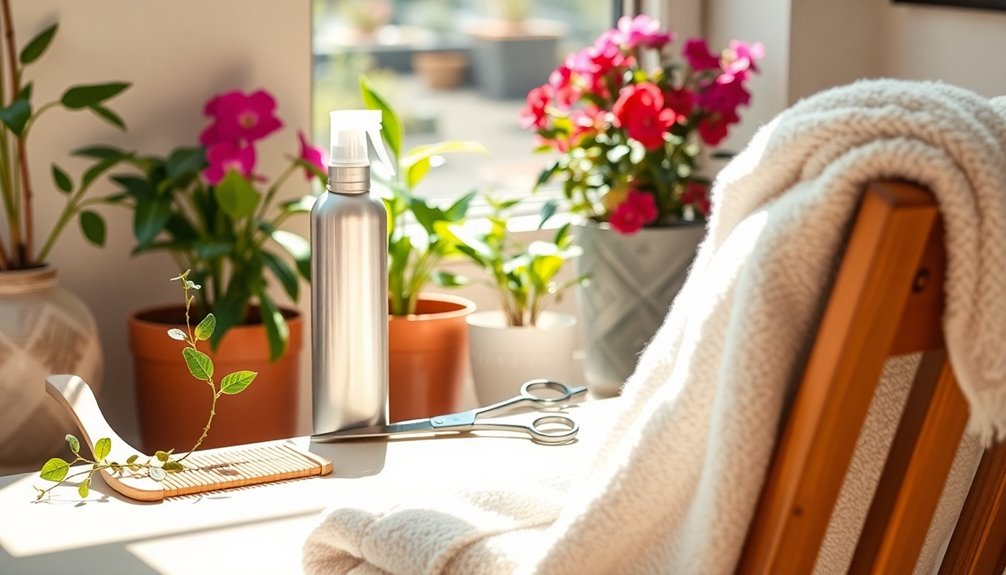
Effective texturizing tools can make all the difference in achieving your desired hairstyle while prioritizing sustainability. Start with eco-friendly hair brushes, like bamboo or dark wood options, which are durable and reduce environmental impact. Eco-friendly products often feature natural ingredients that support healthier hair and scalp.
Boar bristle brushes also provide a natural touch, while ionic tourmaline ceramic brushes, despite their non-eco bristles, come with recyclable packaging to minimize waste. When it comes to combs, opt for wide-tooth versions made from sustainable wood or recyclable materials. Detangler comb sets, featuring flexible bristles, are designed for gentle detangling without damaging your hair.
Bamboo paddle combs and eco-friendly detangler paddles offer both functionality and sustainability. For heat styling, choose tools with adjustable heat settings and digital temperature control. These features not only conserve energy but also protect your hair from excessive damage. Look for tools made from ceramic, tourmaline, or titanium, which ensure even heat distribution. Lastly, consider investing in long-lasting tools built with recyclable materials, as they reduce the need for frequent replacements and help you maintain an eco-conscious approach to your hair care routine.
The Role of Sustainable Salons
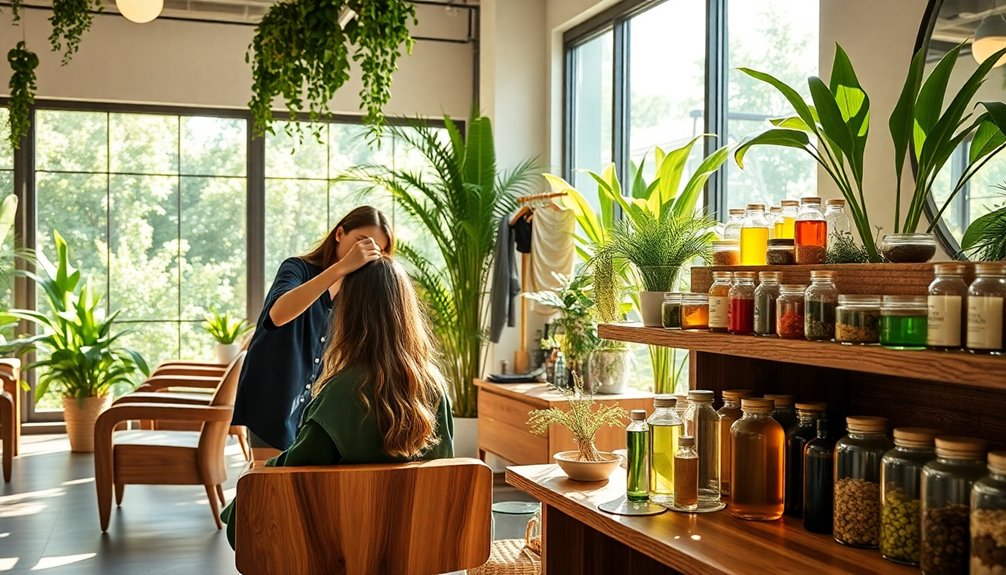
Sustainable salons are transforming the beauty industry, prioritizing eco-friendly practices while enhancing your hair care experience. By utilizing reused materials for salon buildout and updates, these salons create a unique atmosphere that reflects their commitment to the environment.
You'll notice energy-saving practices, like VOC-free paint and ammonia-free hair color lines, which help reduce harmful emissions. Additionally, many sustainable salons have established Green Circle Salon certification to further emphasize their dedication to environmentally conscious practices.
When you visit a sustainable salon, you benefit from services that include Eco Head water filters, ensuring healthier scalp conditions by softening water and reducing volume. Your stylist will likely use eco-friendly products made from sustainable materials, like those with refillable packaging and no animal-derived ingredients.
Sustainable salons also encourage waste management through programs that recycle and compost salon materials. When you bring in empty product bottles, you might even receive a discount as an incentive.
Education plays a key role too; you'll find workshops on sustainability and tips for reducing heat styling, helping you embrace your natural texture.
Finding Eco-Conscious Hair Professionals

Finding eco-conscious hair professionals can feel like a rewarding journey toward healthier hair and a greener planet. Start by looking for stylists certified in sustainable practices. Certifications from organizations focused on environmental sustainability ensure your stylist is knowledgeable about eco-friendly methods and products. Continuous education in new sustainable techniques is a must.
Next, check if your stylist or salon is affiliated with professional organizations promoting sustainability. Membership in such groups often indicates a commitment to green practices and community involvement.
Product knowledge is crucial, too. A good eco-conscious stylist will use biodegradable and non-toxic hair products, steering clear of harmful ingredients like synthetic copolymers and alcohol. For instance, they might recommend products like Beach Waves Ocean Hair Texturizer, which features therapeutic-grade ingredients that are both effective and eco-friendly.
Ask for recommendations on sustainable brands, like Suncoat or Earth Harbor, that prioritize the environment.
DIY Texturizing Tips
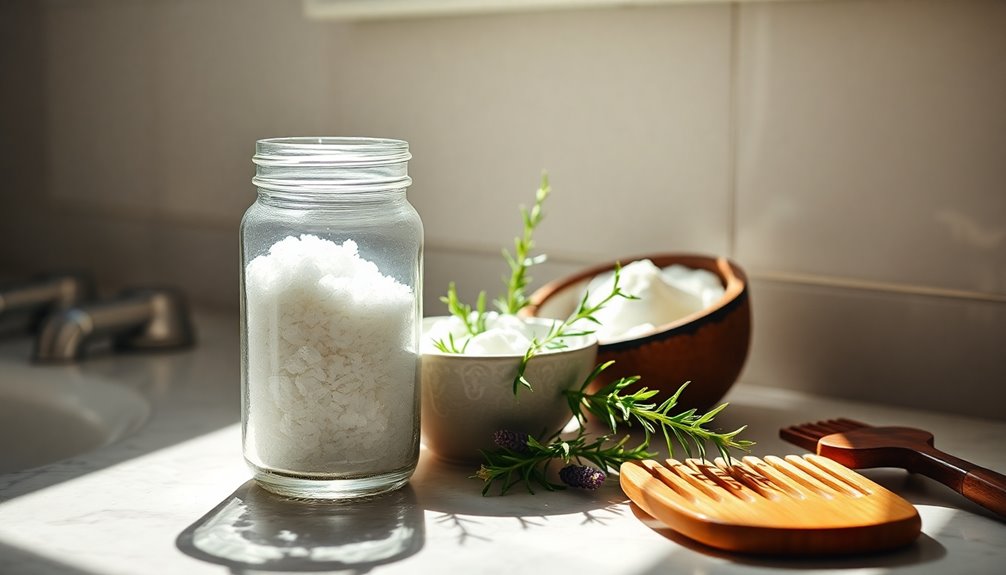
Creating your own hair texturizing products can be a fun and rewarding experience, allowing you to tailor solutions that suit your hair's unique needs.
Start with a DIY texturizing spray using distilled water, sea salt, Epsom salt, coconut oil, and aloe vera gel. Simmer the water, whisk in the salts, oil, and gel, then cool and bottle it. Add essential oils for fragrance and benefits. Spray on clean, slightly damp hair and scrunch for defined waves. This spray not only enhances your hair's texture but also provides resistance to humidity, preventing lifeless locks.
For a texturizing powder, mix cornstarch, kaolin clay, and baking soda. Customize it with essential oils and colored powders to match your hair. Apply to your roots for volume, adjusting the ratio based on your hair type.
Natural texturizing agents like baking soda can enhance curl definition when mixed with water or conditioner. You can also use tea or natural oils like jojoba for added benefits.
Store your creations in airtight glass containers and refrigerate to maintain freshness.
With these tips, you'll not only achieve your desired texture but also embrace sustainable practices in your hair care routine.
Professional vs. At-Home Texturizing
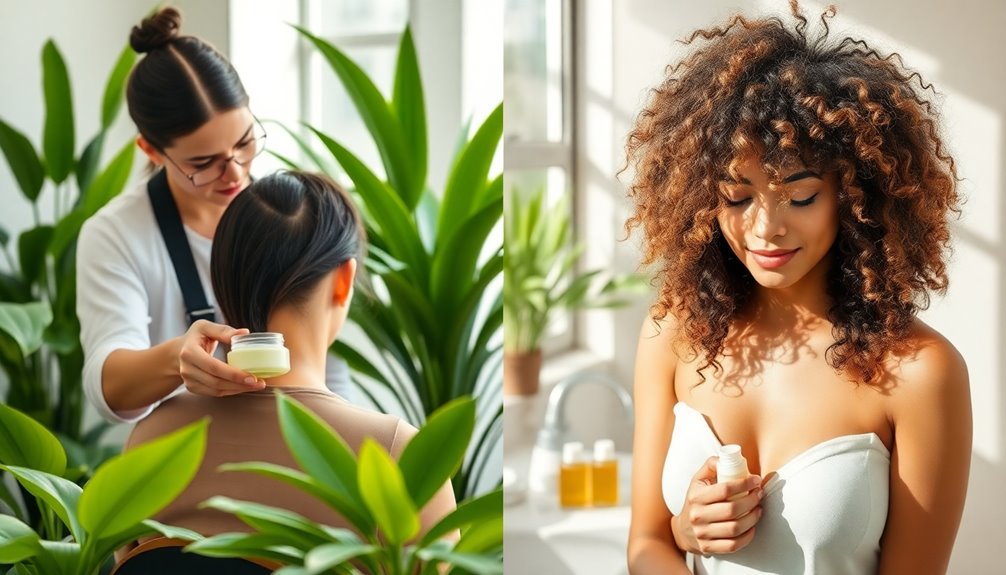
When it comes to texturizing your hair, the choice between professional and at-home methods can significantly impact your results.
Professional stylists use specialized tools like thinning shears and razors, alongside advanced techniques such as point cutting and channel cutting. They customize each service based on your hair type and desired look, ensuring precision and avoiding common mistakes like over-texturizing. Their training and experience allow them to achieve seamless blending and a polished finish, as they consider hair texture to select the most suitable methods for each client. In addition to their hairstyling skills, many professional stylists also appreciate the importance of quality tools beyond cutting instruments. For instance, they often incorporate elements of Japanese makeup brush craftsmanship to enhance the final look, utilizing brushes designed for precision and softness. This meticulous approach underscores their commitment to achieving not just outstanding hairstyles but also a complete, polished appearance that complements each client’s unique features.
On the other hand, at-home texturizing has its limitations. You may struggle with access to professional-grade tools and the skills needed for precise cuts. Basic techniques like point cutting can be attempted, but they often lack the finesse a stylist provides.
Plus, there's a higher risk of unevenness and damage if you're not careful. While DIY products and tutorials can help, they can't replace the expertise of a trained professional.
Ultimately, if you want stunning, lasting results, professional texturizing is your best bet. At home, you might achieve some texture, but it often requires regular touch-ups to maintain the look and health of your hair.
Analyzing Your Hair Type
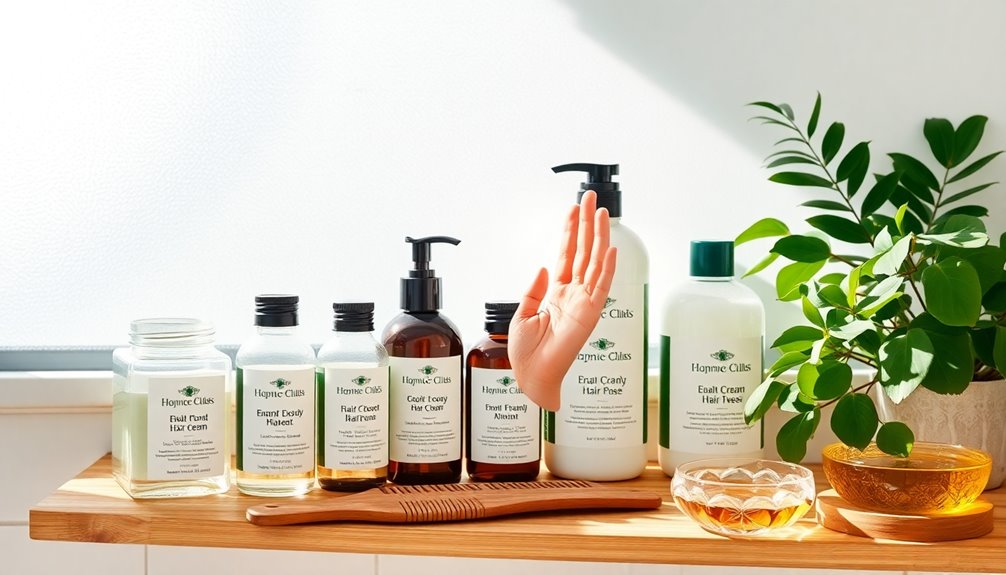
Understanding your hair type is essential for effective texturizing and styling. Start by determining the diameter of each strand to classify your hair as fine, medium, or coarse.
Fine hair feels thin and soft, often prone to flyaways and sensitive to treatments. Medium hair has more texture and body, making it relatively strong but sometimes challenging to keep hydrated. Coarse hair is thicker and can be strong yet stubborn when styling.
Next, test your hair's elasticity. Stretch a damp strand; healthy hair should stretch up to 1/4 of its length and return to its original size. Hair texture analysis can further help in accurately assessing your hair type and recommending suitable products.
If it stretches further or breaks easily, your hair may be porous, indicating damage.
Embracing Natural Hair Texture
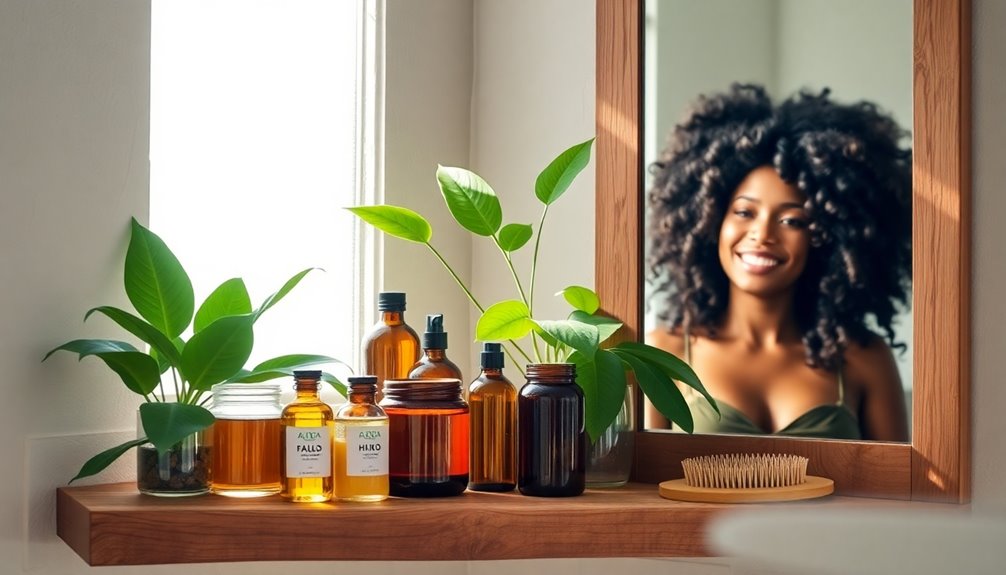
Embracing your natural hair texture can be a transformative experience, as it allows you to celebrate your unique beauty and authenticity. Recognizing that your hair's texture is a vital part of your identity helps you appreciate its distinctiveness.
Instead of comparing your hair to others, focus on enhancing what you have. This self-acceptance fosters confidence and a deeper connection to your true self.
Choosing products tailored to your hair type is crucial. If you have wavy hair, lightweight curl-enhancing products like mousse or texturizing spray work wonders. For curly or coily hair, opt for moisturizing shampoos, conditioners, and natural oils like coconut or jojoba. Different hair textures require unique care and styling techniques, and understanding this will help you choose the right products for your needs.
Avoid heavy styling products and heat tools to prevent damage.
Eco-friendly styling techniques can further support your natural texture. Try twist-outs, braid-outs, or the "plopping" method to define your curls without heat. Use a microfiber towel to reduce frizz, and consider a half-up/half-down hairstyle for effortless style.
Lastly, protect your hair while you sleep with satin or silk pillowcases, and comb gently with a wide-tooth comb. Regularly deep condition to keep your hair moisturized and healthy, allowing your natural beauty to shine.
Frequently Asked Questions
How Can I Identify Truly Eco-Friendly Hair Products?
To identify truly eco-friendly hair products, check for certifications like USDA Organic and Leaping Bunny. Read ingredient labels for natural components, avoid harmful additives, and choose brands with sustainable packaging and manufacturing practices.
Are There Any Certifications for Sustainable Hair Salons?
Yes, you can look for certifications like Climate Neutral, Fairtrade, or 1% for the Planet. These indicate a salon's commitment to sustainability, ensuring environmentally friendly practices and products are used in their services.
What Are the Environmental Impacts of Conventional Hair Products?
Conventional hair products harm the environment through toxic chemicals, microplastics, and excessive waste. They pollute water systems, disrupt ecosystems, and contribute to air pollution, affecting wildlife and human health while depleting natural resources.
Can I Mix Eco-Friendly Products With Conventional Ones?
You can mix eco-friendly products with conventional ones, but be cautious. Harsh chemicals might reduce effectiveness or cause irritation. Try a small amount first to see how your hair responds before fully integrating them.
How Do I Dispose of Hair Products Sustainably?
To dispose of hair products sustainably, empty containers completely, clean them for recycling, and check local guidelines. Consider upcycling or using manufacturer recycling programs to minimize waste and protect the environment effectively.
Conclusion
Incorporating sustainable hair texturizing methods into your routine not only benefits your hair but also the planet. By choosing eco-friendly products and embracing natural styling techniques, you can enhance your hair's texture without compromising on ethics. Remember to analyze your hair type and experiment with DIY tips to find what works best for you. Ultimately, celebrating your natural hair texture while using sustainable practices can lead to healthier hair and a happier planet.

